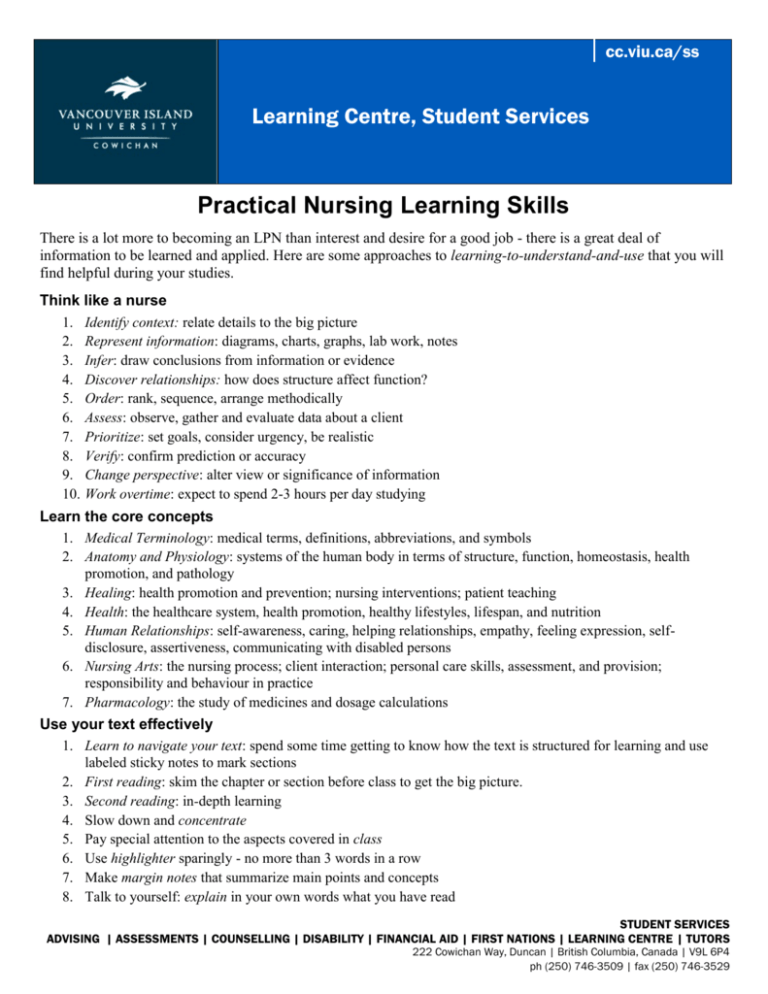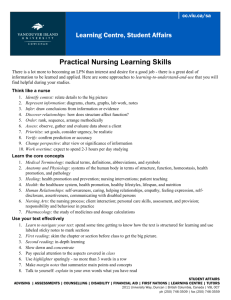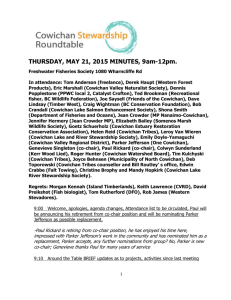Practical Nursing Learning Skills
advertisement

cc.viu.ca/ss Learning Centre, Student Services Practical Nursing Learning Skills There is a lot more to becoming an LPN than interest and desire for a good job - there is a great deal of information to be learned and applied. Here are some approaches to learning-to-understand-and-use that you will find helpful during your studies. Think like a nurse 1. Identify context: relate details to the big picture 2. Represent information: diagrams, charts, graphs, lab work, notes 3. Infer: draw conclusions from information or evidence 4. Discover relationships: how does structure affect function? 5. Order: rank, sequence, arrange methodically 6. Assess: observe, gather and evaluate data about a client 7. Prioritize: set goals, consider urgency, be realistic 8. Verify: confirm prediction or accuracy 9. Change perspective: alter view or significance of information 10. Work overtime: expect to spend 2-3 hours per day studying Learn the core concepts 1. Medical Terminology: medical terms, definitions, abbreviations, and symbols 2. Anatomy and Physiology: systems of the human body in terms of structure, function, homeostasis, health promotion, and pathology 3. Healing: health promotion and prevention; nursing interventions; patient teaching 4. Health: the healthcare system, health promotion, healthy lifestyles, lifespan, and nutrition 5. Human Relationships: self-awareness, caring, helping relationships, empathy, feeling expression, selfdisclosure, assertiveness, communicating with disabled persons 6. Nursing Arts: the nursing process; client interaction; personal care skills, assessment, and provision; responsibility and behaviour in practice 7. Pharmacology: the study of medicines and dosage calculations Use your text effectively 1. Learn to navigate your text: spend some time getting to know how the text is structured for learning and use labeled sticky notes to mark sections 2. First reading: skim the chapter or section before class to get the big picture. 3. Second reading: in-depth learning 4. Slow down and concentrate 5. Pay special attention to the aspects covered in class 6. Use highlighter sparingly - no more than 3 words in a row 7. Make margin notes that summarize main points and concepts 8. Talk to yourself: explain in your own words what you have read STUDENT SERVICES ADVISING | ASSESSMENTS | COUNSELLING | DISABILITY | FINANCIAL AID | FIRST NATIONS | LEARNING CENTRE | TUTORS 222 Cowichan Way, Duncan | British Columbia, Canada | V9L 6P4 ph (250) 746-3509 | fax (250) 746-3529 9. Pay attention to new terms and concepts 10. Know which diagrams to study; pay attention to the explanations 11. Third reading: scan for important diagrams, terms, definitions, and concepts to make study aids (such as a list of terms, a chart, or flash cards) Use all your senses 1. Eyes to look at visuals and read 2. Ears to listen to your instructor and to yourself read and explain aloud 3. Hands to write, draw, highlight, and trace Practice remembering instead of re-looking 1. Think about the difference between looking at something in front of you and not looking at it but being able to understand it, explain it, summarize it, or draw it. Which is expected on a test? Practice that way! 2. Without looking at your text, or notes, say or write a summary of important points—do this at regular intervals. 3. Photocopy diagrams and white out labels; make several copies and practice labeling. Note your mistakes and work on those. 4. When using flashcards, if you don’t know the response, don’t look right away - work on trying to remember. Put the cards that you don’t know in a separate pile and spend time working on those until you know them. Put a tick mark on those you get right and an x on those you don’t know. Consolidate your learning 1. Rewrite your notes to review, fill in gaps, and consolidate learning 2. Restructure or elaborate your notes rather than simply copying them. Learn the two-column note system (sign up for a learning skills session or go online). 3. Make charts: For example, when studying a body system, make a chart with these headings: part, location, structure, function, other (pathology, target drug). 4. Make study notes that are simpler than your revised class notes. Staple them together and keep with you for quick review sessions. Do drills and regular review 1. Flash cards: terms & definitions, diagrams & explanations, questions & answers 2. Study notes: cover up one side of two-column notes 3. Label diagrams until you can do it without error 4. Verbalize by reciting definitions, concepts, etc. Practice answering questions 1. Learn about different types of exam questions (Learning Centre handout) 2. Develop your own questions, based on your class notes 3. Answer the questions at the end of each chapter 4. Write practice tests based on class notes (link below) Identify and use resources 1. Cowichan Campus Learning Centre: Attend a workshop, make an appointment, select useful handouts, request a Volunteer Tutor, go to Room 131 2. Link to online information: http://cc.viu.ca/ss/academic_support.htm 3. Medical Terminology practice test (go to above link) Student Nurse Resources: http://www.studentnursesource.com Cornell Notes: http://lsc.sas.cornell.edu/LSC_Resources/cornellsystem.pdf Learning videos: http://maclife.mcmaster.ca/academicskills/online_resources.cfm M:\Tip Sheets for Students\Learning Centre\Practical Nursing Learning Skills.pub






